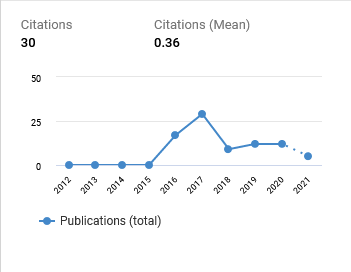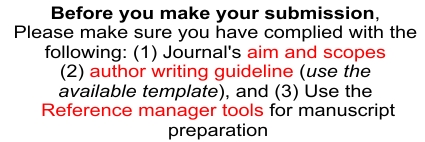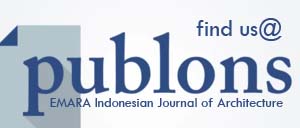Correspondence Between Work Environment Discomfort Factors and The Intention to Move
DOI:
https://doi.org/10.29080/eija.v5i2.694Keywords:
environmental discomfort, inconvenience, intention to move, work environmentAbstract
The work environment has a great influence on motivation, performance and individual willingness to stay in their workspace. It will affect individual intention to move to a better place according to them. This study aims to determine the relationship between discomfort factors on the working environment with the intention to move from a workspace based on the individual indoor worker perception. This study uses qualitative methods and a grounded theory approach with non-random sampling and online questionnaires for data collection. The results revealed that there were five main categories of discomfort in the workspace, that is thermal discomfort, poor interior design, unsupported working atmosphere, inadequate indoor facilities, and poor indoor lighting intensity. Among those five categories, thermal discomfort has become the thing that most influences an individual's desire to move from their workspace. It can be concluded that there are three groups of factors that represent work inconvenience, namely: factors that are very influential, tend to be influential and have less effect on individual inconvenience to their work environment
Downloads
References
Ayu, C. P., Mukzam, M. D., & Iqbal, M. (2016). Pengaruh Stress Kerja Lingkungan, Organisasional, dan Personal terhadap Kepuasan Kerja (Studi pada Karyawan Dinas Ketenagakerjaan dan Transmigrasi Kota Malang). Jurnal Administrasi Bisnis, 34(1), 104–113.
Budianto, A. A. T., & Katini, A. (2017). Pengaruh lingkungan kerja terhadap kinerja pegawai pada PT Perusahaan Gas Negara (PERSERO) Tbk SBU Distribusi wilayah I Jakarta. KREATIF : Jurnal Ilmiah Prodi Manajemen Universitas Pamulang, 3(1). doi: 10.32493/jk.v3i1.y2015.p%p
Creswell, J. W. (2012). Educational Research: Planning, Conducting, and Evaluating Quantitative and Qualitative Research (4th Edition). Boston: Pearson.
Creswell, J. W. (2014). Research Design: Qualitative, Quantitative, and Mixed Methods Approaches (Fourth Edition). Nebraska: SAGE.
Dewi, S. K., & Frianto, A. (2013). Pengaruh Lingkungan Kerja Terhadap Kinerja Karyawan Melalui Motivasi. Jurnal Ilmu Manajemen (JIM), 1(4), 1055–1065.
Febriana, S. K. T. (2013). Faktor-Faktor yang Mempengaruhi Stres Kerja. Jurnal Ecopsy, 1(1), 28–32. doi: 10.20527/ecopsy.v1i1.481
Kumar, R. (2008). Research Methodology. New Delhi: APH Publishing.
Norianggono, Y. C. P., Hamid, D., & Ruhana, I. (2014). Pengaruh Lingkungan Kerja Fisik Dan Non Fisik Terhadap Kinerja Karyawan ( Studi Pada Karyawan PT. Telkomsel Area III Jawa-Bali Nusra di Surabaya ). Jurnal Administrasi Bisnis, 8(2), 1–10.
Rachman, R. A., & Kusuma, H. E. (2014). Definisi Kebetahan dalam Ranah Arsitektur dan Lingkungan-Perilaku – TEMU ILMIAH. Prosiding Temu Ilmiah IPLBI 2014. Presented at the Temu Ilmiah IPLBI, Palembang. Retrieved from https://temuilmiah.iplbi.or.id/definisi-kebetahan-dalam-ranah-arsitektur-dan-lingkungan-perilaku/
Satriaji, K. R. (2017). The study of the student comfortability in Campus environment, Case study: ITSB Campus, Cikarang. ARTEKS : Jurnal Teknik Arsitektur, 2(1), 47–58. doi: 10.30822/arteks.v2i1.40
Surjosuseno, D. (2015). Pengaruh Lingkungan Kerja dan Motivasi Kerja Terhadap Kinerja Karyawan pada Bagian Produksi UD Pabrik ADA Plastic. Agora, 3(2), 175–179.

Downloads
Published
How to Cite
License
Copyright (c) 2019 Fildza Zatalini Zakirah, Hafshah Salamah, Hanson Endra Kusuma

This work is licensed under a Creative Commons Attribution-ShareAlike 4.0 International License.
- Authors retain copyright and grant the journal right of first publication with the work simultaneously licensed under a Creative Commons Attribution ShareAlike License that allows others to share the work with an acknowledgment of the work's authorship and initial publication in this journal.
- Authors are able to enter into separate, additional contractual arrangements for the non-exclusive distribution of the journal's published version of the work (e.g., post it to an institutional repository or publish it in a book), with an acknowledgment of its initial publication in this journal.
- Authors are permitted and encouraged to post their work online (e.g., in institutional repositories, pre-print sites, or on their website) prior to and during the submission process, as it can lead to productive exchanges, as well as earlier and greater dissemination of published work.
































